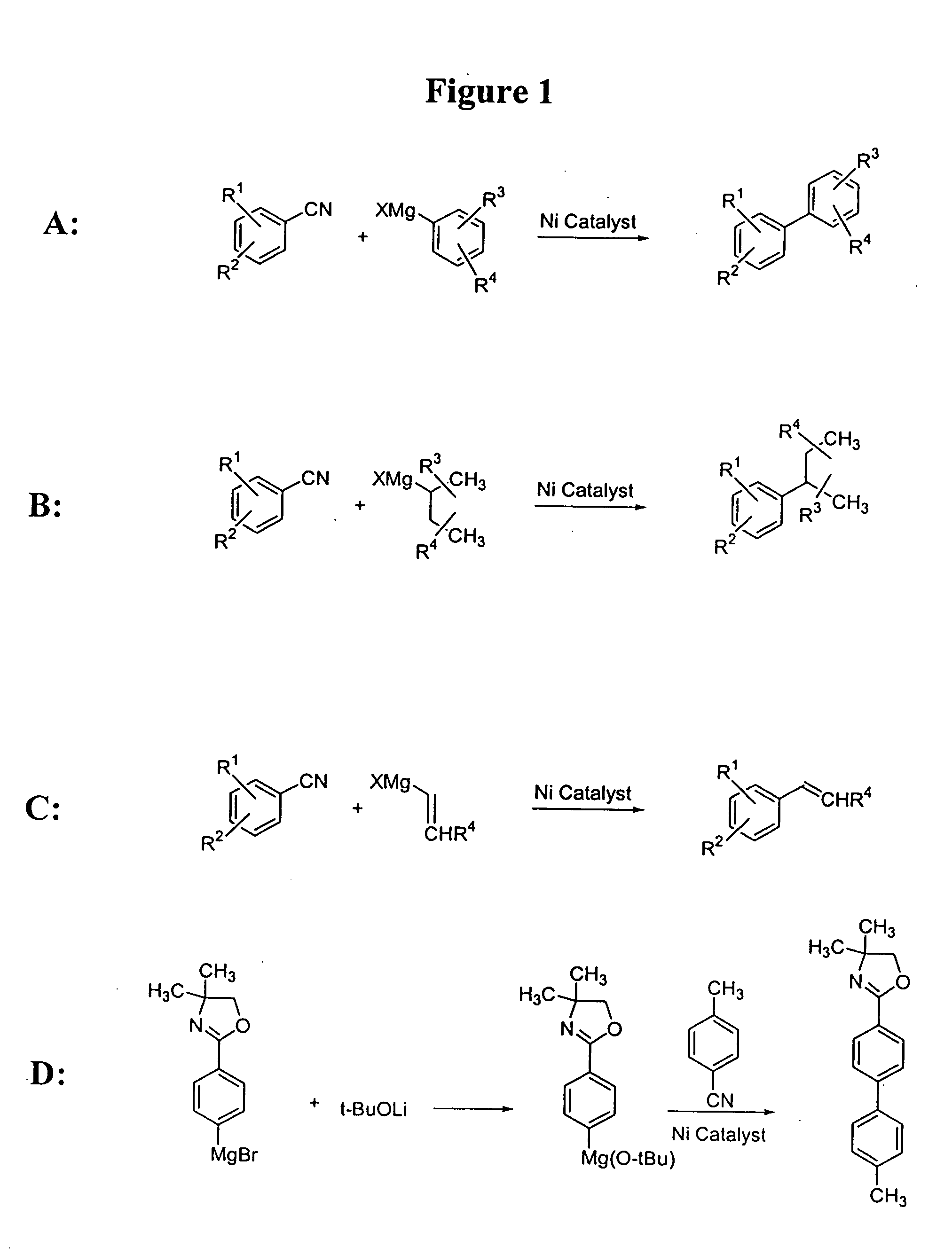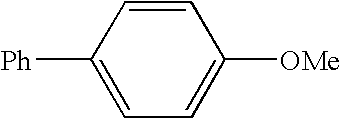Process for preparing unsymmetrical biaryls and alkylated aromatic compounds from arylnitriles
a technology of arylnitrile and biaryl, which is applied in the field of preparation of unsymmetrical biaryls and alkylated aromatic compounds from arylnitriles, can solve the problems of limiting the usefulness of this method, limiting the number of functional groups (e.g., aldehydes, ketones, esters and nitro groups) that are not compatible with the conditions of the kharasch reaction, and restricting the substitution of organi
- Summary
- Abstract
- Description
- Claims
- Application Information
AI Technical Summary
Benefits of technology
Problems solved by technology
Method used
Image
Examples
example 1
[0072] This example illustrates the preparation of 4-phenylanisole by a nickel catalyzed coupling of 4-methoxybenzonitrile with phenylmagnesium chloride / lithium t-butoxide.
[0073] A solution of lithium t-butoxide in THF (4.4 mL of 1.0 M solution; 4.4 mmol) was treated at room temperature with phenylmagnesium chloride (2.8 mL; 4.0 mmol; 1.40 M in THF) and the resulting solution heated at 60° C. for 1 h. After cooling to room temperature, the reaction solution was treated with a solution of 4-methoxybenzonitrile (0.27 g, 2.0 mmol), dichlorobis(trimethylphosphine)nickel (0.028 g; 5 mol %), and tridecane (0.18 g; 1.0 mmol; internal GC standard) in THF (2 mL). The reaction mixture was then heated to 60° and stirred for 2 h. A sample was withdrawn and quenched in a mixture of 1 M sodium citrate (aq) and ether. GC analysis of the organic phase of the hydrolyzed reaction sample showed the presence of 1.82 mmol (91% yield) of 4-phenylanisole, 0.06 mmol of 4-methoxybenzophenone imine, 0.04 mm...
example 2
[0074] In this example, a zinc reagent is used in place of the magnesium reagent of Example 1 to prepare 4-phenylanisole by the nickel catalyzed coupling of 4-methoxybenzonitrile with phenylzinc chloride.
[0075] A solution of zinc chloride (0.48 g; 3.5 mmol) in THF (5 mL) was treated at 0° C. with phenylmagnesium chloride (2.1 mL of a 1.40 M solution in THF; 3.0 mmol) and then stirred at room temperature for 30 min. The mixture of phenylzinc chloride thus obtained was then treated with a solution of 4-methoxybenzonitrile (0.27 g; 2.0 mmol), dichlorobis(trimethylphosphine)nickel (0.028 g; 5 mol %), and tridecane (0.18 g; 1.0 mmol; internal GC standard) in THF (2 mL) and heated at 60° C. for 8 h. A sample was withdrawn and quenched in a mixture of 1 M sodium citrate (aq) and ether. GC analysis of the organic phase of the hydrolyzed reaction sample showed the presence of 0.90 mmol (45% yield) of 4-phenylanisole, no 4-methoxybenzophenone imine, 0.38 mmol of anisole, 0.82 mmol of bipheny...
example 3
[0076] This example illustrates that use of an aryl Grignard compound (e.g., ArMgX; X=halide) instead of a derivatized aryl Grignard reagent (e.g., the adduct derived from ArMgX and LiOBu-t or LiSPh) in the Ni-catalyzed coupling reaction with benzonitriles. 4-phenylanisole is prepared by the nickel catalyzed coupling of 4-methoxybenzonitrile with phenylmagnesium chloride
[0077] Phenylmagnesium chloride (2.1 mL of a 1.4 M solution in THF; 3.0 mmol) was diluted with additional THF (3 mL) and treated at room temperature with a solution of 4-methoxybenzonitrile (0.27 g; 2.0 mmol), dichlorobis(trimethylphosphine)nickel (0.028 g; 5 mol %), and tridecane (0.18 g; 1.0 mmol; internal GC standard) in THF (2 mL). The reaction was heated at 60° C. for 90 min and then a sample was withdrawn and quenched in a mixture of 1 M sodium citrate (aq) and ether. GC analysis of the organic phase of the hydrolyzed reaction sample showed the presence of 1.42 mmol (71% yield) of 4-phenylanisole, 0.36 mmol of...
PUM
| Property | Measurement | Unit |
|---|---|---|
| temperature | aaaaa | aaaaa |
| temperature | aaaaa | aaaaa |
| mol % | aaaaa | aaaaa |
Abstract
Description
Claims
Application Information
 Login to View More
Login to View More - R&D
- Intellectual Property
- Life Sciences
- Materials
- Tech Scout
- Unparalleled Data Quality
- Higher Quality Content
- 60% Fewer Hallucinations
Browse by: Latest US Patents, China's latest patents, Technical Efficacy Thesaurus, Application Domain, Technology Topic, Popular Technical Reports.
© 2025 PatSnap. All rights reserved.Legal|Privacy policy|Modern Slavery Act Transparency Statement|Sitemap|About US| Contact US: help@patsnap.com



